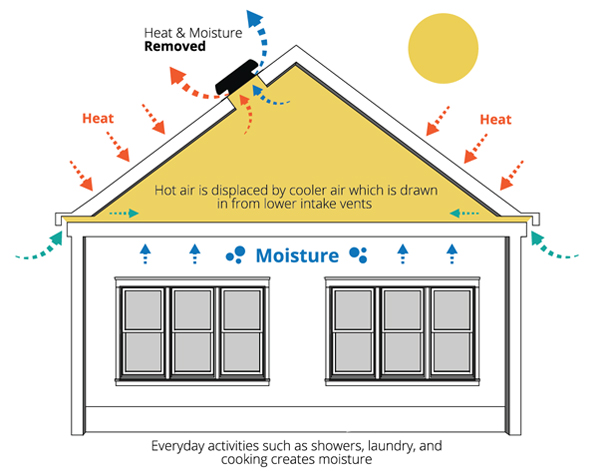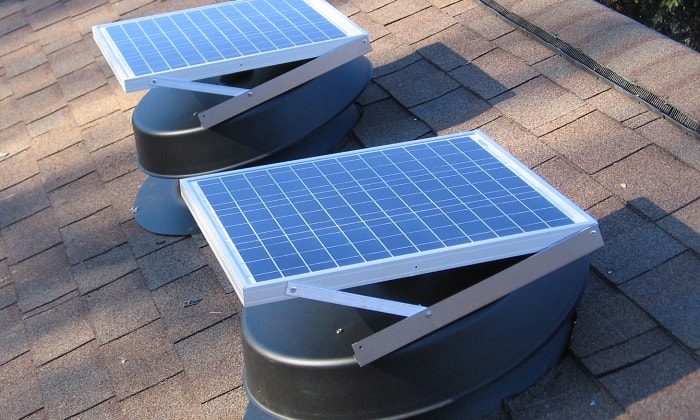Having an attic fan can lessen the energy costs of air conditioning, especially during summer. In addition, it also avoids condensation and prevents the formation of ice dams in winter.
It is placed in the ceiling at times, specifically designed to suit over a hole in the ceiling or set inside a gable end. Moreover, an attic fan also serves as extra air conditioning where it sucks up circulating warm air inside a house going into the attic then emits it outside through a vent in the attic. But to correctly size it for a home is not an easy task. There are some excellent guides online about how to size an attic fan, and we will put together some pointers for you below.
How It Works
Without an attic fan, the warm air in the attic can get out into the house and constrains the air conditioner to work double and more complex to maintain cool air inside the home. This is where an attic fan can come in handy.
Using an attic fan, the exhausted warm air from the inside will be replaced by cooler air from outside, passing through the windows. Hence, the process cools the whole house.
However, your attic fan must be sized correctly to work best, and here are the steps in determining the right size for your attic. This will make your place cozier to appreciate the good things in life.
Steps to Correctly Sizing an Attic Fan

Materials Needed
A tape measure and calculator
House Air Volume
First, you need to figure out the air volume of your attic. This can be done by measuring the width and length of your attic floor using a tape measure. Then, the next step is to calculate the measured length by multiplying it with the width of your attic’s floor.
After this, you need to get the total of each floor of your attic to figure out the entire square foot area of your house floor. Finally, multiply the total floor area times the average height of your roof to determine the total of your attic’s air volume in cubic feet.
Size of Attic
To get the attic size, you should calculate the width by multiplying it with the length of your attic floor in feet. For example, a single house attic typically has the same square footage as the entire house and any connected garage area.
Size of Vent Fan
The next step is to calculate the square feet of the attic’s space by multiplying it with 0.7 to determine the minimum average of cubic feet of volume air per minute to estimate the fan’s movement.
However, an additional 20% is needed for a steep roof and 15% for houses with dark roofs. Typically, attic fans are assessed from 800 to 1,600 cubic feet per minute (CFM), which can make one fan fit for an attic with a size of roughly 2,200 square feet.
Location of Vent Fan
Then, you can place the roof fans on the roof’s back under the ridge in the middle part of the attic. You can also position gable fans on the gable end vent of your house, fronting away from the winds.
Air Vents Intake
Your fan needs to have many underside vents or gables to pull out air towards the attic. So, to determine if vent space is enough, you should divide the assessment of the fan in cubic feet per minute by 300 to yield the smallest number of square feet of needed inlet vent space for a specific fan size.
Thermostat of Fan
After this, you need to adjust the thermostat of the attic fan, and it should range between 100 to 110 degrees Fahrenheit.
In addition, if moisture in your attic becomes high, a humidity sensor should be available. An attic fan can save you 3 to 4 percent on your energy bills for every increase in the thermostat setting during summer.
Ridge Vent
If the ridge vent is positioned, it’s generally not ideal to utilize a vent fan since there is a tendency that the fan will bring in air from the ridge vent. As a result, this functions against the usual purpose of the ridge to release warm air off the attic when it is high.
Other Tips
Lastly, you can install two or more fans if your roof space cannot fit one larger fan.
Conclusion
Attic fans play an essential role in cooling your house during summer. They also reduce your energy bill costs as they can supplement air conditioners.
However, it’s best to remember that attic fans should have proper wiring and be installed only by professionals.





